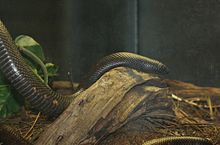Calabar python
| Calabar python | |
|---|---|
 |
|
| Scientific classification | |
| Kingdom: | Animalia |
| Phylum: | Chordata |
| Class: | Reptilia |
| Order: | Squamata |
| Suborder: | Serpentes |
| Family: | Boidae |
| Genus: |
Calabaria (Gray, 1858) |
| Species: | C. reinhardtii |
| Binomial name | |
|
Calabaria reinhardtii (Schlegel, 1851) |
|
| Synonyms | |
The Calabar python (Calabaria reinhardtii) is a nonvenomous boa species endemic to west and central Africa.
The specific name or epithet, reinhardtii, is dedicated to Danish herpetologist Johannes Theodor Reinhardt (1816–1882).
Although Schlegel (1848) first assigned this taxon to the genus Eryx, most herpetologists have since regarded it as a python, which is still reflected in many of its common names. Kluge (1993) referred it to Charina (Erycinae) based on a phylogenetic analysis. Charina was used to group together C.bottae and C.trivirgata with C.reinhardtii to emphasize evidence for an historical connection between the New and Old Worlds, as well as for taxonomic efficiency. All recent analyses however place Calabaria reinhardtii at the base of a large monophyletic Boidae clade, which consists (beside of Calabaria) of some "Boinae" subclades, an African Erycinae subclade and an American subclade made up of Charina (Lichanura included) and Ungaliophiinae.
This species was long regarded as a member of the family Pythonidae; a fact still reflected in many of its common names. It was moved to Charina by Kluge (1993) based on a phylogenetic analysis; however, analyses based on DNA show that Calabaria is not closely related to Charina, and instead it appears to represent an ancient branch of the boiid snakes with no close living relatives.
...
Wikipedia
